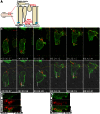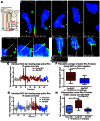Rho activation is apically restricted by Arhgap1 in neural crest cells and drives epithelial-to-mesenchymal transition
- PMID: 23804498
- PMCID: PMC3931734
- DOI: 10.1242/dev.095448
Rho activation is apically restricted by Arhgap1 in neural crest cells and drives epithelial-to-mesenchymal transition
Abstract
Epithelial-to-mesenchymal transitions (EMTs) are crucial for morphogenesis and carcinoma metastasis, yet mechanisms controlling the underlying cell behaviors are poorly understood. RhoGTPase signaling has been implicated in EMT; however, previous studies have yielded conflicting results regarding Rho function, and its role in EMT remains poorly understood. Elucidation of precise Rho functions has been challenging because Rho signaling is highly context dependent and its activity is tightly regulated spatiotemporally within the cell. To date, few studies have examined how Rho affects cell motility in intact organisms, and the pattern of Rho activity during motile cell behaviors of EMT has not been determined in any system. Here, we image endogenous active Rho during EMT in vivo, and analyze effects of Rho and Rho-kinase (ROCK) manipulation on cell motility in vivo. We show that Rho is activated in a discrete apical region of premigratory neural crest cells during EMT, and Rho-ROCK signaling is essential for apical detachment and generation of motility within the neuroepithelium, a process that has been poorly understood. Furthermore, we find that Arhgap1 restricts Rho activation to apical areas, and this restriction is necessary for detachment. Our results provide new insight into mechanisms controlling local Rho activation and how it affects dynamic cell behaviors and actomyosin contraction during key steps of EMT in an intact living organism.
Keywords: EMT; GAP; Neural crest; RhoGTPase; Zebrafish.
Figures







Similar articles
-
Cadherin 6 promotes neural crest cell detachment via F-actin regulation and influences active Rho distribution during epithelial-to-mesenchymal transition.Development. 2014 Jun;141(12):2506-15. doi: 10.1242/dev.105551. Development. 2014. PMID: 24917505 Free PMC article.
-
Rho-kinase and myosin II affect dynamic neural crest cell behaviors during epithelial to mesenchymal transition in vivo.Dev Biol. 2008 Dec 15;324(2):236-44. doi: 10.1016/j.ydbio.2008.09.013. Epub 2008 Sep 24. Dev Biol. 2008. PMID: 18926812 Free PMC article.
-
Prickle1 is required for EMT and migration of zebrafish cranial neural crest.Dev Biol. 2019 Apr 1;448(1):16-35. doi: 10.1016/j.ydbio.2019.01.018. Epub 2019 Feb 2. Dev Biol. 2019. PMID: 30721665 Free PMC article.
-
Neural crest development: insights from the zebrafish.Dev Dyn. 2020 Jan;249(1):88-111. doi: 10.1002/dvdy.122. Epub 2019 Oct 22. Dev Dyn. 2020. PMID: 31591788 Free PMC article. Review.
-
PleiotRHOpic: Rho pathways are essential for all stages of Neural Crest development.Small GTPases. 2014;5:e27975. doi: 10.4161/sgtp.27975. Epub 2014 Mar 10. Small GTPases. 2014. PMID: 24614304 Free PMC article. Review.
Cited by
-
Cellular dynamics of EMT: lessons from live in vivo imaging of embryonic development.Cell Commun Signal. 2021 Jul 22;19(1):79. doi: 10.1186/s12964-021-00761-8. Cell Commun Signal. 2021. PMID: 34294089 Free PMC article. Review.
-
Pard3 regulates contact between neural crest cells and the timing of Schwann cell differentiation but is not essential for neural crest migration or myelination.Dev Dyn. 2014 Dec;243(12):1511-23. doi: 10.1002/dvdy.24172. Epub 2014 Oct 1. Dev Dyn. 2014. PMID: 25130183 Free PMC article.
-
Divide or Conquer: Cell Cycle Regulation of Invasive Behavior.Trends Cell Biol. 2017 Jan;27(1):12-25. doi: 10.1016/j.tcb.2016.08.003. Epub 2016 Sep 12. Trends Cell Biol. 2017. PMID: 27634432 Free PMC article. Review.
-
Transforming growth factor beta signaling and craniofacial development: modeling human diseases in zebrafish.Front Cell Dev Biol. 2024 Feb 7;12:1338070. doi: 10.3389/fcell.2024.1338070. eCollection 2024. Front Cell Dev Biol. 2024. PMID: 38385025 Free PMC article. Review.
-
Apical Sarcomere-like Actomyosin Contracts Nonmuscle Drosophila Epithelial Cells.Dev Cell. 2016 Nov 7;39(3):346-358. doi: 10.1016/j.devcel.2016.09.023. Epub 2016 Oct 20. Dev Cell. 2016. PMID: 27773487 Free PMC article.
References
-
- Ahn Y.-H., Gibbons D. L., Chakravarti D., Creighton C. J., Rizvi Z. H., Adams H. P., Pertsemlidis A., Gregory P. A., Wright J. A., Goodall G. J., et al. (2012). ZEB1 drives prometastatic actin cytoskeletal remodeling by downregulating miR-34a expression. J. Clin. Invest. 122, 3170–3183 - PMC - PubMed
-
- Bakin A. V., Tomlinson A. K., Bhowmick N. A., Moses H. L., Arteaga C. L. (2000). Phosphatidylinositol 3-kinase function is required for transforming growth factor beta-mediated epithelial to mesenchymal transition and cell migration. J. Biol. Chem. 275, 36803–36810 - PubMed
-
- Barfod E. T., Zheng Y., Kuang W. J., Hart M. J., Evans T., Cerione R. A., Ashkenazi A. (1993). Cloning and expression of a human CDC42 GTPase-activating protein reveals a functional SH3-binding domain. J. Biol. Chem. 268, 26059–26062 - PubMed
Publication types
MeSH terms
Substances
Grants and funding
LinkOut - more resources
Full Text Sources
Other Literature Sources
Molecular Biology Databases
Miscellaneous

